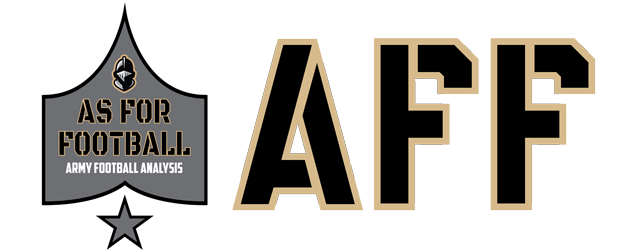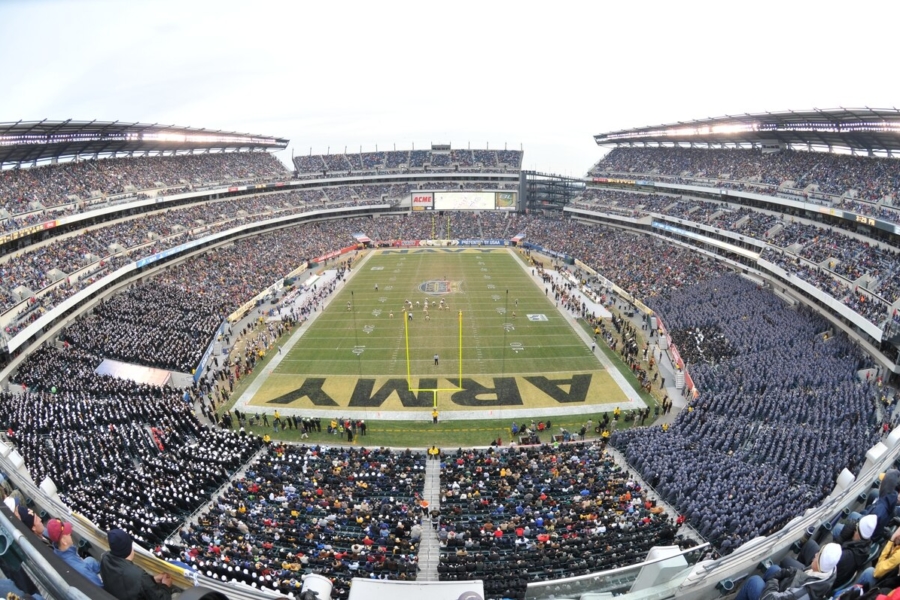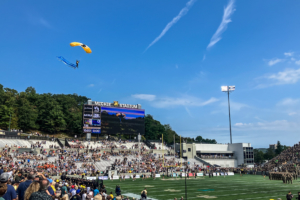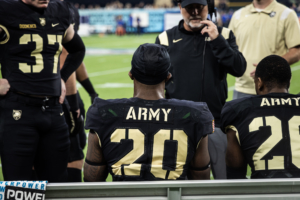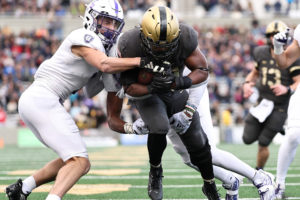Embracing Army Football means embracing the history and traditions of the Black Knights of the Hudson, one of college football’s oldest, most history-rich, tradition-laden programs.
Every school has traditions. Texas A&M has the 12th man, FSU has Chief Osceola, and Clemson has the rock. The following list gives newcomers to Black Knights fandom a brief introduction to Army Football’s history and traditions. With that will hopefully come a sense of the Army football team, truly one of football’s most storied institutions.
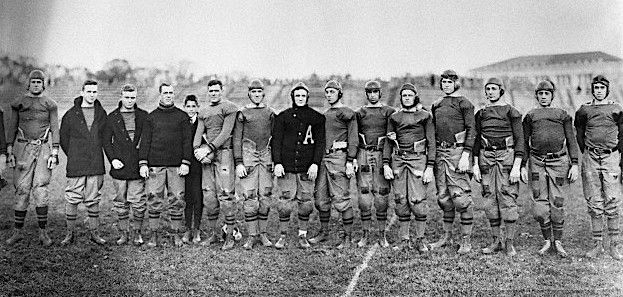
Dwight D. Eisenhower (3rd from left) and Omar Bradley (far right) as part of the 1912 West Point football team. — via Wikipedia.
Uniforms
In recent years, uniforms have become less about what players wear and more about branding for recruiting and marketing. Because of this, some programs–like Oregon–go all out while others–like Penn State–stick with a single classic look all the time.
Army sits somewhere in the middle. The uniforms themselves change over the course of the season, but some things are uniquely West Point. For example, there are no player names on the backs of the jerseys, just “Army”. Or sometimes the West Point motto, “Duty, Honor, Country”. This is because everyone on the roster plays for the team, not for themselves. Instead, the players’ names go on the front of the jersey where they would be on a typical military uniform. Similarly, the team honors an Army division with helmet decals, unit patches, and a divisional flag at every game.
For the Army-Navy game, Army Football wears special uniforms. In recent years, the Academy’s History Department has worked with Nike to create custom designs that honor a heroic unit from a specific time and place in the U.S. Army’s illustrious history. The Black Knights snapped the streak in uniforms that honored the 82nd Airborne’s jump into Normandy, France on D-Day. The next year, West Point honored the 10th Mountain Division’s fight in Italy, while last year’s uniforms honored the 1st Infantry Divisions fight in Word War I.
The Parachute Jump
Most teams don’t make a big deal about bringing the game ball into the stadium. Some teams use it as an opportunity to honor a Make a Wish patient or to thank a wealthy alumnus who’s just written a big check.
At Army, the Parachute Team jumps into the stadium carrying the ball.
That’s right, they strap the game ball to a cadet, who then jumps from a helicopter into Michie Stadium.
Yeah. It’s pretty damn cool.
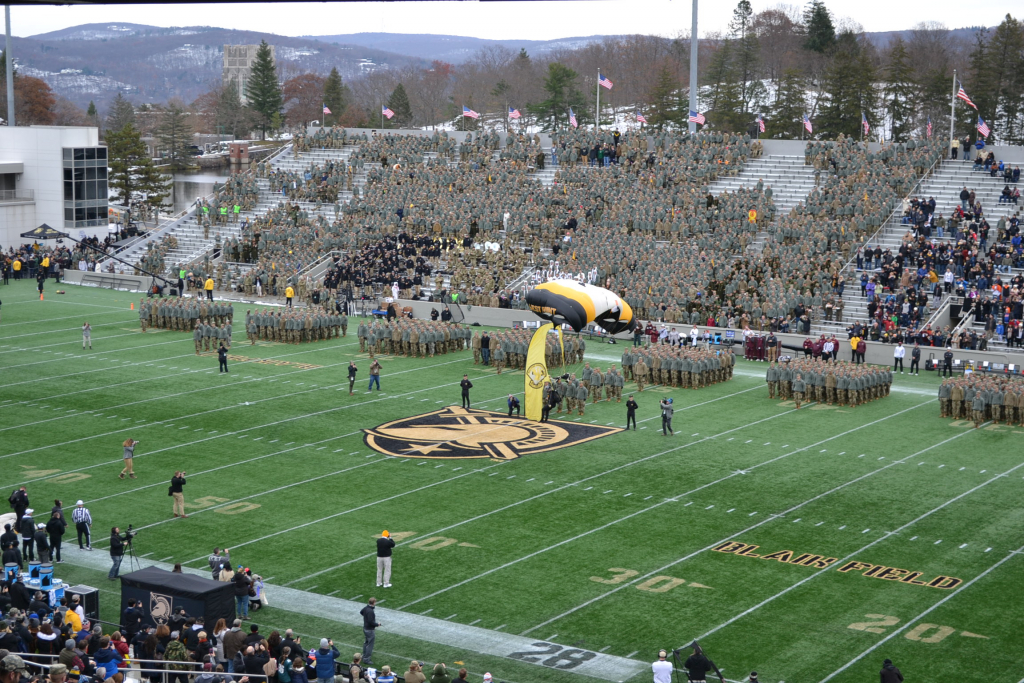
“What a beautiful landing!”
The March-On and Gameday
Most programs have some form of pregame ritual involving the band. Ohio State and USC are perhaps the most famous, and for good reason.
Army marches a full regiment of cadets onto the field in formation before games alongside the United States Military Academy Band. They stay on the field during the parachute jump, and then the cadets lead the crowd in a traditional cheer called The Rocket.
A battery of cannons volley-fire to announce kickoff. Army mules roam the sidelines, and the cannons fire again for touchdowns. Cadets do push-ups whenever Army scores. The Cadet Band plays the greatest fight song in college football, “On Brave Old Army Team,” and every cadet and alumnus sings because the words are part of the Academy’s required knowledge. Those words–and many, many others–must be memorized out of Bugle Notes or, more likely, the New Cadet Handbook as part of Beast Barracks.
History
You want history? Check this out:
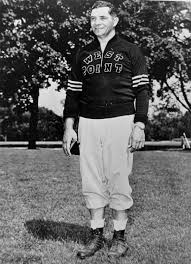
Lombardi at Army.
1. Army was one of the first schools to start playing college football.
2. The Army-Navy game is one of college football’s longest running rivalries.
3. Army has won three national championships–1944, 1945,and 1946.
4. Army’s 1945 team is widely considered to have been the most dominant team in college football history.
5. Army has three Heisman Trophy winners–Glenn Davis, Doc Blanchard, and Pete Dawkins
6. In the 1946 national championship, Army played Notre Dame in a contest dubbed “the game of the century”. They still call it that.
7. None other than the legendary Vince Lombardi spent arguably the more formative years of his early coaching career at West Point, learning the importance of execution, attention to detail, and perseverance as an assistant coach under Army’s iconic head coach Colonel Earl “Red” Blaik.
Visitors to Michie stadium should make sure to walk through the Kimsey Center and the Army Sports Hall of Fame to get a sense of this. The Hall has everything from 1930s-era football helmets to bathrobes from the 70s, earned as part of a traditional Army-Navy bet. It is an amazing testament to the achievement and service of more than a century of Academy athletes.
Felix "Doc" Blanchard, Mr. Inside, is a 3x Nat Champ with @armywp_football. He won the @HeismanTrophy, @TheMaxwellAward and the Sullivan Award, all in 1945. After #armyfootball, he was in the US #airforce from ‘47-‘71 when he retired with the rank of colonel. pic.twitter.com/QNvh43u0i9
— Sons of Slum and Gravy (@OfSlumandGravy) May 3, 2019
The Army-Navy Game
The greatest tradition of all is the Army-Navy Game. There is something truly unique and special about this game. Many call it the “greatest rivalry in sports”, and as such, it has its own weekend on college football’s calendar. Every other rivalry game takes place earlier in the season or on rivalry weekend. Army-Navy is played the second Saturday in December, and it’s the only FBS game that day.
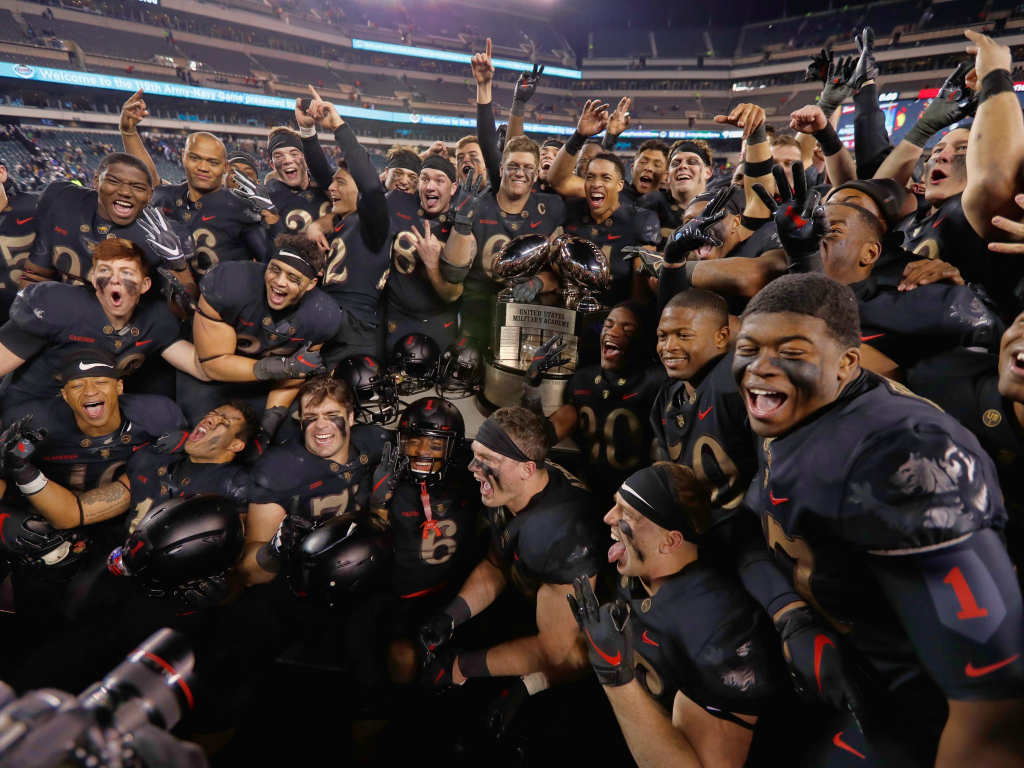
Celebrating three straight after Army-Navy 2018.
Most schools have conference, state, and traditional rivals, and many have a “hate week” for every team. Army-Navy, though, is a year-round affair. The rivalry never ends. Cadets BEAT NAVY from their first days at the Academy until their last days of Grad Week and eternally thereafter. Everywhere at West Point, one only has to look to see reminders of the rivalry and how much it means.
The very first Army-Navy Game was played all the way back on November 29, 1890. Since then, the rivalry has been renewed 119 times, usually in Philadelphia. The birthplace of American democracy just so happens to lie halfway between West Point, New York, and Annapolis, Maryland.

Army-Navy 1908 via Wikipedia.
Army-Navy fever really gripped the nation in the years after World War II. Time was when every American family had at least one veteran–and most had more than one. In Army Football’s heyday, the Army-Navy Game was a callback to the nation’s sacrifice and triumph, a time for families to not only watch a football game but to remember their shared service and sacrifice as well. For better or worse, the all-volunteer force means that today’s viewers are far less likely to own a piece of Army-Navy’s tradition for themselves. However, the game still celebrates the service of its players and reminds Americans of the fighting men and women who serve on their behalf.

